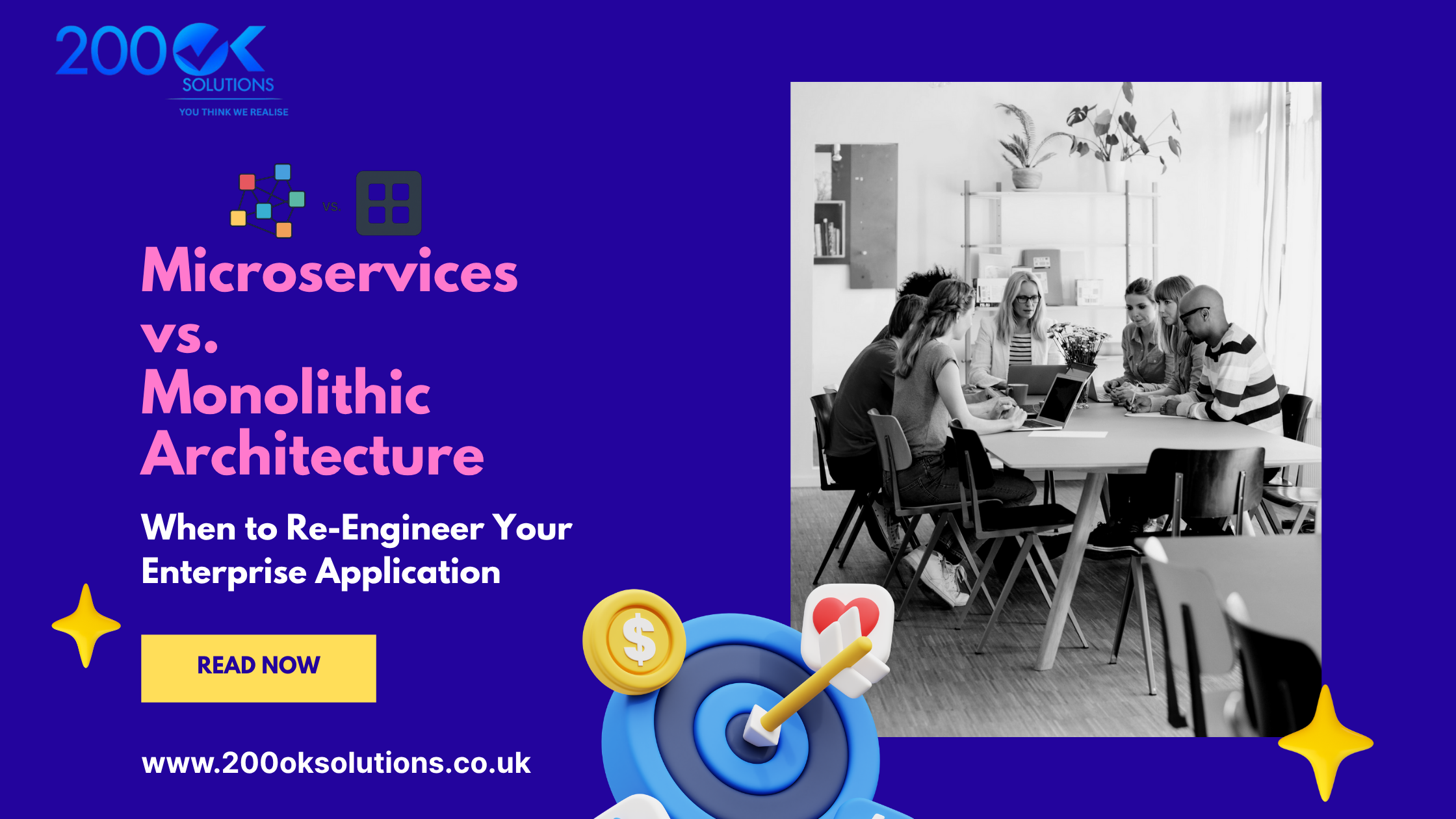Should you migrate your enterprise application from monolithic to microservices architecture in 2025? The answer depends on your specific scaling challenges, team structure, and business goals. While microservices offer superior scalability and deployment flexibility for large, complex applications, monolithic architecture remains the better choice for smaller teams, simpler applications, or when rapid initial development is needed. For UK enterprises facing performance bottlenecks, frequent deployment conflicts, or multi-team coordination issues, re-engineering to microservices can deliver significant benefits—but only with proper planning and a phased migration approach.
Understanding the Core Architectural Differences
What is Monolithic Architecture?
Monolithic architecture represents a traditional software design approach where all components of an enterprise application—user interface, business logic, data access layers, and integrations—exist as a single, unified codebase deployed as one unit.
Key characteristics of monolithic applications:
- Single deployable unit with all functionality bundled together
- Shared database across all application modules
- Tight coupling between components and features
- Unified technology stack throughout the application
- Simpler initial development and deployment process
- All components scale together as one entity

What is Microservices Architecture?
Microservices architecture breaks down enterprise applications into small, independent services that each handle specific business capabilities. Each microservice operates autonomously with its own database, development cycle, and deployment pipeline.
Key characteristics of microservices:
- Multiple independent services communicating via APIs
- Decentralized data management with service-specific databases
- Loose coupling enabling independent development and deployment
- Technology diversity allowing different stacks per service
- Complex orchestration and inter-service communication
- Granular scaling of individual services based on demand
Pros and Cons: Microservices vs Monolithic Architecture for UK Enterprises
Monolithic Architecture Advantages
Simplicity in Development and Testing
- Faster initial development with straightforward architecture
- Easier debugging with all code in one place
- Simpler end-to-end testing without network calls
- Lower learning curve for new developers
Operational Efficiency
- Single deployment pipeline reduces complexity
- Easier monitoring with one application instance
- Lower infrastructure costs for smaller applications
- Reduced DevOps overhead for small teams
Performance Benefits
- In-process communication faster than network calls
- No inter-service latency or network overhead
- Simpler transaction management within single database
- Better performance for data-intensive operations
Monolithic Architecture Limitations
Scaling Challenges
- Must scale entire application even when only one module needs resources
- Higher infrastructure costs as application grows
- Difficulty handling varying load patterns across features
- Limited ability to optimize individual components
Development Bottlenecks
- Large codebase becomes difficult to navigate and understand
- Deployment conflicts increase with multiple teams
- Long build and test cycles slow down releases
- Higher risk of unintended consequences from changes
- Team coordination overhead grows with application size
Technology Lock-in
- Difficult to adopt new technologies without full rewrite
- Stuck with legacy frameworks and dependencies
- Harder to modernize incrementally
- Limited flexibility in choosing optimal tools per feature
Microservices Architecture Advantages
Scalability and Performance
- Independent scaling of services based on actual demand
- Optimal resource allocation per service
- Better handling of traffic spikes to specific features
- Improved fault isolation preventing cascade failures
Development Velocity
- Multiple teams work independently without conflicts
- Faster deployment cycles for individual services
- Easier to understand and modify smaller codebases
- Reduced coordination overhead between teams
Technology Flexibility
- Choose best technology stack for each service
- Easier adoption of new frameworks and tools
- Incremental modernization without full rewrites
- Freedom to optimize each service independently
Cloud-Native Benefits
- Better alignment with cloud migration strategies in UK
- Easier containerization with Docker and Kubernetes
- Natural fit for DevOps and CI/CD practices
- Improved disaster recovery and resilience
Microservices Architecture Challenges
Operational Complexity
- Requires sophisticated DevOps architecture and tooling
- Complex monitoring across distributed services
- Challenging debugging and troubleshooting
- Higher infrastructure and operational costs
- Need for service mesh, API gateways, and orchestration
Data Management Difficulties
- Distributed transactions across services are complex
- Data consistency challenges without shared database
- Increased data duplication and synchronization needs
- Complicated reporting and analytics across services
Development Overhead
- Inter-service communication adds latency and failure points
- API versioning and backward compatibility requirements
- Need for comprehensive automated testing
- Higher initial development investment
- Steeper learning curve for teams new to distributed systems
When to Re-Engineer Your Enterprise App to Microservices

Clear Indicators It’s Time to Migrate
1. Scaling Pain Points
Your monolithic application shows these scalability issues:
- Cannot scale individual features independently
- Infrastructure costs escalating due to uniform scaling
- Performance bottlenecks in specific modules affecting entire system
- UK data centers struggling with resource allocation efficiency
2. Team Growth and Organization
Your development organization exhibits:
- Multiple teams working on same codebase causing conflicts
- Frequent deployment bottlenecks and merge conflicts
- Slow release cycles despite larger development teams
- Teams waiting for others to complete deployments
3. Technology Constraints
Your application faces:
- Legacy technology stack limiting innovation
- Difficulty adopting modern frameworks or languages
- Need for different technologies for specific capabilities
- Challenges meeting new UK compliance requirements efficiently
4. Business Agility Requirements
Your business needs:
- Faster time-to-market for new features
- Ability to experiment with features without full redeployments
- Independent service lifecycle management
- Different SLAs for different application components
5. Cloud Migration Goals
Your modernization strategy includes:
- Moving to cloud infrastructure in UK regions
- Adopting containerization and Kubernetes
- Implementing comprehensive DevOps architecture
- Leveraging cloud-native services and patterns
When to Keep Your Monolithic Architecture
Stick with monoliths when you have:
- Small teams (under 10-15 developers) – Coordination overhead of microservices outweighs benefits
- Simple, well-defined applications – Limited features don’t justify distributed complexity
- Limited DevOps maturity – Lack of automation and monitoring capabilities
- Tight development deadlines – Need rapid initial delivery before optimizing architecture
- Budget constraints – Cannot invest in infrastructure and tooling for microservices
- Straightforward scaling needs – Uniform scaling works for your use case
- Tightly coupled business logic – Domain doesn’t naturally decompose into services
The Hybrid Approach: Modular Monolith Architecture

For many UK enterprises in 2025, the modular monolith represents an excellent middle ground between traditional monolithic and full microservices architecture.
What is a Modular Monolith?
A modular monolith maintains single deployment while organizing code into well-defined, loosely coupled modules with clear boundaries and interfaces.
Key benefits of modular monoliths:
- Maintain simplicity of monolithic deployment
- Achieve better code organization and team boundaries
- Enable easier future migration to microservices if needed
- Reduce coordination overhead while improving modularity
- Lower operational complexity than full microservices
- Flexibility to extract modules to services when justified
Best practices for modular monolith:
- Define clear module boundaries based on business capabilities
- Enforce strict API contracts between modules
- Implement separate databases per module within monolith
- Use dependency injection and interface-based design
- Organize teams around modules for ownership clarity
- Monitor module dependencies to prevent coupling
Roadmap: Monolithic to Microservices Migration UK
Phase 1: Assessment and Planning (2-3 months)
Evaluate Current State
- Audit existing monolithic application architecture
- Identify performance bottlenecks and scaling issues
- Assess team capabilities and DevOps maturity
- Document current deployment processes and challenges
Define Business Drivers
- Establish clear migration objectives and success metrics
- Calculate expected cost benefits of re-engineering
- Identify high-priority services for extraction
- Set realistic timeline and resource requirements
Technical Preparation
- Design target microservices architecture
- Choose technology stack and cloud platform (AWS, Azure, Google Cloud UK regions)
- Plan API gateway and service mesh strategy
- Define data migration and synchronization approach
Phase 2: Foundation Building (3-6 months)
Infrastructure Setup
- Implement CI/CD pipelines for automated deployment
- Set up container orchestration (Kubernetes)
- Deploy monitoring and logging infrastructure
- Establish API gateway and service discovery
- Configure security and authentication services
Team Enablement
- Train teams on microservices patterns and practices
- Establish development standards and guidelines
- Define service ownership and responsibility model
- Create documentation and runbook templates

Phase 3: Strangler Pattern Migration (6-18 months)
Incremental Service Extraction
- Identify first service candidate (low risk, high value)
- Extract service while maintaining monolith functionality
- Route traffic through API gateway to new service
- Monitor performance and stability closely
- Gradually retire corresponding monolith code
Prioritize Service Extraction Order:
- Stateless services – Easier to extract with minimal data dependencies
- Services with scaling needs – Immediate performance benefits
- Services with independent lifecycle – Different release cadences
- Services for new features – Build new capabilities as microservices
- Core business services – Extract after proving pattern success
Phase 4: Data Migration Strategy
Approaches for managing data in microservices:
- Implement database-per-service pattern gradually
- Use Change Data Capture (CDC) for data synchronization
- Maintain referential integrity through service APIs
- Consider event sourcing for complex data flows
- Plan for eventual consistency where appropriate
Phase 5: Optimization and Scaling (Ongoing)
Continuous Improvement
- Monitor service performance and optimize bottlenecks
- Refine service boundaries based on actual usage
- Improve automation and deployment processes
- Enhance observability and debugging capabilities
- Review and adjust resource allocation
Challenges Migrating Monolith to Microservices in UK
Common Pitfalls to Avoid
Over-Engineering Early
- Don’t create too many small services initially
- Start with larger, well-defined services
- Focus on clear business boundaries over technical decomposition
- Avoid creating microservices for the sake of architecture
Underestimating Complexity
- Distributed systems introduce network failures and latency
- Debugging becomes significantly more challenging
- Data consistency requires careful design and trade-offs
- Operational overhead increases dramatically
Inadequate DevOps Infrastructure
- Must have automated deployment and testing before migrating
- Monitoring and observability are non-negotiable requirements
- Service mesh and API gateway needed for production readiness
- Without automation, microservices become unmanageable
Ignoring Data Challenges
- Distributed transactions are extremely difficult
- Data migration strategy must be planned meticulously
- Eventual consistency requires application-level handling
- Reporting and analytics across services need new approaches
Best Practices for Microservices Re-Engineering in UK
1. Start with Strong DevOps Foundation
- Implement comprehensive CI/CD pipelines
- Establish automated testing at all levels
- Deploy centralized logging and monitoring
- Use infrastructure-as-code for consistency
2. Design for Failure
- Implement circuit breakers and retry logic
- Use timeouts and fallback mechanisms
- Design services to be resilient and self-healing
- Practice chaos engineering to test resilience
3. Maintain Service Independence
- Avoid shared databases between services
- Communicate through well-defined APIs only
- Version APIs carefully to maintain compatibility
- Minimize synchronous dependencies between services
4. Invest in Observability
- Implement distributed tracing across services
- Use centralized logging aggregation
- Monitor business metrics alongside technical ones
- Create comprehensive dashboards for system health
5. Manage Organizational Change
- Align team structure with service boundaries
- Establish clear service ownership and accountability
- Create communities of practice for knowledge sharing
- Invest in training and skill development
Enterprise Microservices Adoption Trends in UK 2025

Current State of Microservices Adoption
Industry Statistics:
- 70% of UK enterprises are either using or evaluating microservices architecture
- Financial services and e-commerce leading adoption rates
- Average migration timeline: 18-36 months for large enterprises
- Cloud-native applications predominantly using microservices
Emerging Patterns:
- Hybrid approaches gaining traction over pure microservices
- Service mesh technologies (Istio, Linkerd) becoming standard
- Serverless microservices for event-driven workloads
- GraphQL adoption for simplified API consumption
UK-Specific Considerations
Regulatory and Compliance
- GDPR compliance influencing data residency decisions
- Financial services regulations affecting architecture choices
- Data sovereignty requirements for UK-hosted services
- Security standards impacting service communication
Cloud Provider Presence
- AWS London, Azure UK, Google Cloud UK regions
- Multi-cloud strategies for resilience and compliance
- Edge computing considerations for UK users
- Brexit implications for data transfer and hosting
Cost-Benefits Analysis: Re-Engineering to Microservices UK
Investment Requirements
Initial Migration Costs:
- Infrastructure modernization: £100K-£500K depending on scale
- Team training and hiring: £50K-£200K for specialized skills
- Tool and platform licenses: £20K-£100K annually
- Consultant and advisory services: £50K-£300K
- Development time opportunity cost: 20-40% velocity reduction during migration
Ongoing Operational Costs:
- Increased cloud infrastructure spend: 30-50% initially (optimizes over time)
- DevOps and SRE team expansion: £200K-£500K annually
- Monitoring and observability tools: £30K-£100K annually
- Service mesh and supporting infrastructure: £20K-£80K annually
Return on Investment
Quantifiable Benefits:
- Deployment frequency increase: 10x-100x after full migration
- Mean time to recovery (MTTR): 60-80% reduction
- Infrastructure cost optimization: 20-40% savings after optimization
- Development velocity: 30-50% improvement with proper team structure
- Time to market: 40-60% faster for new features
Strategic Benefits:
- Improved business agility and competitive advantage
- Enhanced ability to scale for growth
- Better technical talent attraction and retention
- Increased innovation through technology flexibility
- Reduced technical debt and modernized stack
Breakeven Timeline:
- Small enterprises (under 50 users): 3-5 years (often not justified)
- Mid-size enterprises: 18-36 months
- Large enterprises: 12-24 months
- High-growth startups: 6-18 months
Frequently Asked Questions
Q: How long does it take to migrate from monolithic to microservices?
A: For UK enterprises, a complete migration typically takes 18-36 months depending on application complexity and team size. A phased approach using the strangler pattern allows you to deliver value incrementally. Small to medium applications might complete migration in 12-18 months, while large, complex enterprise systems may require 3-5 years for full transformation.
Q: Can we adopt microservices gradually without rewriting everything?
A: Yes, absolutely. The strangler pattern is specifically designed for gradual migration. You extract services one at a time while keeping the monolith operational, routing traffic through an API gateway. This approach minimizes risk, allows learning from each extraction, and delivers incremental benefits. Many UK enterprises successfully maintain hybrid architectures indefinitely, extracting only services where microservices provide clear advantages.
Q: What team size justifies moving to microservices?
A: Generally, teams with 15+ developers working on the same application start benefiting from microservices due to reduced coordination overhead. With smaller teams, the operational complexity of microservices often outweighs the benefits. However, team size isn’t the only factor—consider application complexity, scaling requirements, and deployment frequency as well.
Q: How do microservices affect application performance?
A: Microservices introduce network latency for inter-service communication, which can slow individual operations compared to in-process monolithic calls. However, they enable independent scaling of bottleneck services, often improving overall system performance and user experience. Proper caching, async communication, and API optimization are essential for maintaining performance.
Q: What DevOps tools are essential for microservices?
A: Essential tools include: container orchestration (Kubernetes), CI/CD platforms (Jenkins, GitLab, GitHub Actions), service mesh (Istio, Linkerd), API gateway (Kong, AWS API Gateway), monitoring and observability (Prometheus, Grafana, Datadog), and centralized logging (ELK stack, Splunk). UK enterprises should ensure these are in place before migrating.
Q: Should startups begin with microservices or monolithic architecture?
A: Most startups should start with a well-structured monolithic or modular monolithic architecture. This allows rapid development, faster iteration, and simpler operations with small teams. Migrate to microservices only when you experience specific scaling pain points, have multiple teams, or have proven product-market fit. Premature adoption of microservices can slow early-stage development significantly.
Q: How do we handle data consistency across microservices?
A: Microservices typically use eventual consistency rather than strong consistency. Implement patterns like saga pattern for distributed transactions, event sourcing for audit trails, and CQRS (Command Query Responsibility Segregation) for read/write optimization. Accept that some data will be temporarily inconsistent and design business logic to handle this gracefully. For critical transactions requiring strong consistency, keep related data within a single service.
Q: What’s the difference between microservices and modular monolith?
A: A modular monolith organizes code into loosely coupled modules with clear boundaries but deploys as a single application. Microservices deploy each module as an independent service with its own process and database. Modular monoliths offer better organization than traditional monoliths while avoiding microservices’ operational complexity. They’re an excellent intermediate step or permanent architecture for many applications.
Making the Right Choice for Your Enterprise
Choosing between microservices and monolithic architecture isn’t a binary decision—it’s about selecting the right architecture for your specific context in 2025.
Choose microservices re-engineering when you have:
- Large development teams (15+ developers) needing independent work
- Clear scaling bottlenecks requiring granular resource allocation
- Mature DevOps practices with comprehensive automation
- Business needs for rapid, independent feature deployment
- Complex domains with natural service boundaries
- Resources for increased operational complexity
- Cloud migration and modernization strategies in UK

Maintain or build monolithic architecture when you have:
- Small teams focused on rapid initial development
- Simple, cohesive application domains
- Limited DevOps infrastructure and expertise
- Tight budget constraints
- Straightforward scaling requirements
- Need for simplicity in operations and debugging
Consider modular monolith as middle ground when you have:
- Medium-sized teams wanting better code organization
- Desire for future microservices optionality
- Need for simplicity but facing growth
- Want to improve without full architectural overhaul
Taking the Next Steps
If you’re a UK enterprise considering application modernization in 2025, 200OK Solutions can help you navigate the complexity of architectural decisions and execute successful migrations.
Our expertise includes:
- Comprehensive architecture assessment and planning
- Microservices migration strategy and roadmap
- DevOps architecture design and implementation
- Cloud migration to UK regions (AWS, Azure, Google Cloud)
- Modular monolith design and refactoring
- Team training and capability building
The journey from monolithic to microservices requires careful planning, technical expertise, and organizational change management. Whether you choose full microservices migration, modular monolith approach, or optimized monolithic architecture, the key is aligning your technical decisions with business objectives.
Ready to evaluate your application architecture? Contact 200OK Solutions for a comprehensive assessment of your enterprise application and a customized modernization roadmap tailored to your UK business needs.


